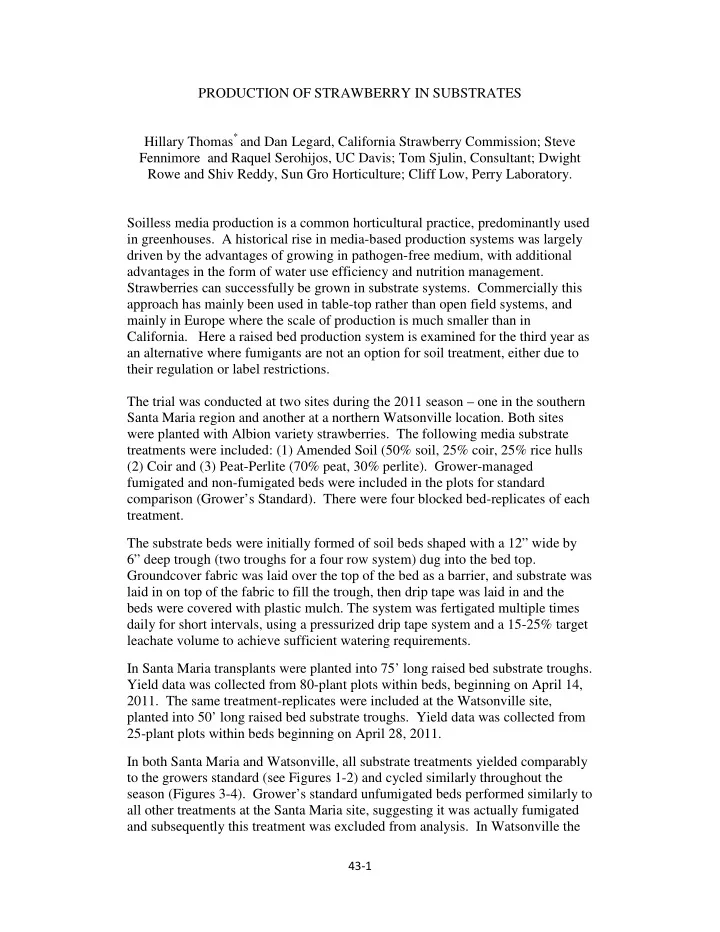

PRODUCTION OF STRAWBERRY IN SUBSTRATES Hillary Thomas * and Dan Legard, California Strawberry Commission; Steve Fennimore and Raquel Serohijos, UC Davis; Tom Sjulin, Consultant; Dwight Rowe and Shiv Reddy, Sun Gro Horticulture; Cliff Low, Perry Laboratory. Soilless media production is a common horticultural practice, predominantly used in greenhouses. A historical rise in media-based production systems was largely driven by the advantages of growing in pathogen-free medium, with additional advantages in the form of water use efficiency and nutrition management. Strawberries can successfully be grown in substrate systems. Commercially this approach has mainly been used in table-top rather than open field systems, and mainly in Europe where the scale of production is much smaller than in California. Here a raised bed production system is examined for the third year as an alternative where fumigants are not an option for soil treatment, either due to their regulation or label restrictions. The trial was conducted at two sites during the 2011 season – one in the southern Santa Maria region and another at a northern Watsonville location. Both sites were planted with Albion variety strawberries. The following media substrate treatments were included: (1) Amended Soil (50% soil, 25% coir, 25% rice hulls (2) Coir and (3) Peat-Perlite (70% peat, 30% perlite). Grower-managed fumigated and non-fumigated beds were included in the plots for standard comparison (Grower’s Standard). There were four blocked bed-replicates of each treatment. The substrate beds were initially formed of soil beds shaped with a 12” wide by 6” deep trough (two troughs for a four row system) dug into the bed top. Groundcover fabric was laid over the top of the bed as a barrier, and substrate was laid in on top of the fabric to fill the trough, then drip tape was laid in and the beds were covered with plastic mulch. The system was fertigated multiple times daily for short intervals, using a pressurized drip tape system and a 15-25% target leachate volume to achieve sufficient watering requirements. In Santa Maria transplants were planted into 75’ long raised bed substrate troughs. Yield data was collected from 80-plant plots within beds, beginning on April 14, 2011. The same treatment-replicates were included at the Watsonville site, planted into 50’ long raised bed substrate troughs. Yield data was collected from 25-plant plots within beds beginning on April 28, 2011. In both Santa Maria and Watsonville, all substrate treatments yielded comparably to the growers standard (see Figures 1-2) and cycled similarly throughout the season (Figures 3-4). Grower’s standard unfumigated beds performed similarly to all other treatments at the Santa Maria site, suggesting it was actually fumigated and subsequently this treatment was excluded from analysis. In Watsonville the 43-1
grower’s standard fumigated suffered a lapse in fertility management in late May and was excluded from the statistical comparison as well. Overall, soilless substrate production in this modified raised bed system produces competitively with respect to plants managed under current (grower’s standard) production practices but the system is not yet competitive economically. Further investigation into cost-saving practices including the incorporation of cheaper amendments or the incorporation of clean soil into substrate beds, reuse of substrates over multiple seasons, and the recycling of fertigation water and nutrients are the focus of future trials. Advantages • Pathogen-free growing substrate • Water and nutrient management • Compatible with traditional strawberry production practices (equipment, labor) Disadvantages • Currently cost-prohibitive • Limitations in substrate availability Further Investigation • Cost cutting measures including re-use of substrate for multiple seasons, amendment of substrates with clean soil and other cheap/available materials and the re-use of fertigation water. • Efficiency and ease of using the production system on a commercial scale • Transportation and waste disposal issues 43-2
Figure 1. Total yield collected between April 14 and August 2, 2011 from 80- plant Albion variety strawberry plots in Santa Maria, Ca (N=4; 320 plants total). Plants were grown in various media substrate treatments. Grower’s standard is grown in fumigated soil. Figure 2. Total yield collected between April 28 and August 1, 2011 from 25- plant Albion variety strawberry plots in Watsonville, Ca (N=4; 100 plants total). Plants were grown in various media substrate treatments. Grower’s standard unfumigated was grown in unfumigated soil. 43-3
Coir Marketable Peat/Perlite Marketable Amended Soil Marketable Grower Standard Fum Marketable 18 16 14 Yield (kg) 12 10 8 6 4 2 0 4/13 4/16 4/20 4/23 4/27 4/30 5/4 5/7 5/11 5/14 5/17 5/20 5/24 5/27 5/31 6/1 6/7 6/10 6/14 6/17 6/20 6/28 7/1 7/5 7/12 7/18 7/21 7/26 7/29 8/2 Figure 3. Yield (kg) over time collected between April 14 and August 2, 2011 from 80-plant Albion variety strawberry plots in Santa Maria, Ca (N=4; 320 plants total). Plants were grown in various media substrate treatments. Grower’s standard was grown in fumigated soil. Coir Marketable Peat/Perlite Marketable Amended Soil Marketable Grower Standard Non-Fum Marketable Grower's Standard Fum EARLY Grower's Standard Fume LATE 10 8 Yield (Kg) 6 4 2 0 4/28 5/2 5/5 5/9 5/12 5/16 5/19 5/23 5/26 5/30 6/2 6/6 6/9 6/13 6/16 6/20 6/23 6/27 6/30 7/4 7/7 7/11 7/14 7/18 7/21 7/25 7/28 8/1 Figure 4. Yield (kg) over time between April 28 and August 1, 2011 from 25-plant Albion variety strawberry plots in Watsonville, Ca (N=4; 100 plants total). Plants were grown in various media substrate treatments. Grower’s standard unfumigated was grown in unfumigated soil and is split into two curves covering early and late season because of differences in fertility program management. 43-4
Recommend
More recommend